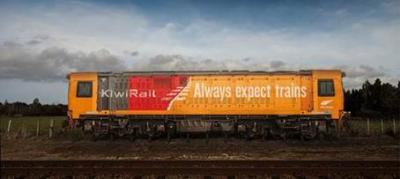The ‘Expect Trains’ campaign – jointly developed and funded by the Transport Agency, KiwiRail and TrackSAFE NZ - aims to get people off autopilot when crossing rural railway tracks and has previously featured at North Island level crossings.
The locomotive-sized billboard and other signs are placed near high risk, selected rural railway level crossings. The billboard, transported by Toll NZ, acts as a visual reminder for drivers to slow down and check for real trains before they cross the railway tracks.Like many rural level crossings, the Rakaia level crossing at Hatfield Overdale Road is protected by a Stop sign only, no flashing lights, bells or barrier arms.Brett Aldridge, Senior Manager, Rail Safety, for the Transport Agency, says the campaign is the result of research that showed that local people can be complacent around railway level crossings that they use regularly.“Local drivers often underestimate how dangerous railway level crossings can be and while train movements might be infrequent, these are huge pieces of equipment and they are absolutely unforgiving.“Complacency can lead to risky behaviour like failing to carefully look for trains before crossing railway tracks. We really want drivers in rural areas like Rakaia to be aware that failing to check carefully for that train could be a fatal oversight. These collisions also have a devastating effect upon train drivers. We are hoping the life-sized train billboard will alert people to the risk.”Complacency at rural level crossings by local drivers is likely to be because they have grown up around railway tracks and drive across level crossings every day – possibly multiple times a day. Previous experience is that they don’t normally come across a train.“Services on rural train lines are usually infrequent which means local drivers may not encounter operating trains at regular intervals. This can lead to complacency and drivers sometimes fail to look properly in both directions,” says KiwiRail Group General Manager Zero Harm Katie McMahon.“It’s really important to always expect trains at any time, from either direction at level crossings. Drivers approaching crossings should slow down and prepare to stop.”TrackSAFE NZ Manager Megan Drayton says the national rail safety charitable trust supports any initiative that has the potential to improve safety and reduce incidents at railway level crossings.
“There are hundreds of rural railway level crossings in New Zealand that just have Stop or Give Way signs, and the onus at those crossings is on the motorist to take care by obeying the signs. This campaign raises awareness of the need to always look for trains, and is extremely valuable,” she says.
The Transport Agency has a role in promoting safe use of the rail corridor by rail operators, road users and pedestrians. As part of this role, the Transport Agency runs awareness campaigns and works with other organisations in the rail sector. The billboard will be stationed at Rakaia for several months. Background
- On average there are around 22 collisions per year between trains and motor vehicles on public road crossings.
- Trains cannot stop quickly and they can't deviate from their course.
- A laden freight train travelling at 80kph can take more than a kilometre to stop.
- If you see a train coming, don't try to race it across the line. Trains can be moving at 80kph or more and will bear down on your vehicle very quickly.
- This is the first time this campaign has reached the South Island. The Canterbury region was chosen for the campaign as it has the highest number of railway level crossings, and in particular a high number of passively protected crossings (level crossings protected only by Give Way and Stop signs – no bells or barrier arms).
- The Hatfield Overdale Road railway level crossing near Ashburton has had two collisions, resulting in two people dying, one person being serious injured, one person with a minor injury, and one near collision between a train and a vehicle in the last eight years.
- There are approximately 11 planned trains a day (not including specials, work trains, charter services, etc) and approximately 150 vehicles a day which pass through the crossing on this section of the Main South Line.
- The crossing was upgraded from Give Way signs to Stop signs in 2016.
- e billboard has previously been installed in the Wairarapa, Central Hawke's Bay, Rangitikei, and Ruapehu districts in the North Island.
- Just under half (47%) of the 1,320 public road railway level crossings on KiwiRail’s national network are protected by Give Way or Stop signs, with the remainder protected by a combination of bells, alarms and barriers.
- There are also an additional 1,300 railway level crossings on private land, mostly rural, protected solely by Give Way or Stop signs.

